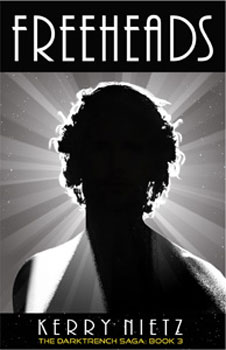‘Freeheads’: A Finale At Liberty
Whoa. I did not expect that. That’s one thing a great story should make you say.
You also want to say that after a great series. It’s what I said after I read Freeheads, the final episode of Kerry Nietz’s The DarkTrench Saga sharia-law-and-space-opera trilogy.
 That’s my best attempt at describing its genre. Yet Freeheads exceeded my expectations thanks in part to Nietz’s continuing genre blends. In this conclusion, I should have expected yet another added ingredient of classic sci-fi.
That’s my best attempt at describing its genre. Yet Freeheads exceeded my expectations thanks in part to Nietz’s continuing genre blends. In this conclusion, I should have expected yet another added ingredient of classic sci-fi.
A Star Curiously Singing explored a future Earth under Sharia law (that is, as interpreted by militant Islam) — to some a utopian future, but for most, dystopian.
In The Superlative Stream, our heroes leave that dystopian world far behind in favor of a familiar-yet-fresh interstellar journey. This ends at a pseudo-utopian place straight out of a classic Star Trek episode, with similar subversion yet better theology (and special effects).
Now Nietz explores one final science-fiction element untouched in the series: time travel.
That’s what surprised me most. A close second is Freeheads’ of-course-that-makes-sense emphasis on Earth’s moon. This builds not only on story seeds in A Star Curiously Singing, but on the imagery and mythology of Islam itself. Here both setting and story reflect the light of the Son — a Son Who, though unseen, is ready to reclaim this long-suffering world.
1. Hero and plot. Having escaped from a utopia-proven-otherwise, Sandfly and his fellow liberated debugger, HardCandy, rush back through space to their home on planet Earth. Here I don’t wish to spoil the story’s first surprise, so I’ll only say this: they don’t find the exact world they, or readers, would expect. Before, they left to seek the distant source of a mysterious signal from space; one would expect that, having met this Source personally, they now return to spread the news to a world crippled by militant Islam, evangelism-style.
Given Sandfly’s appeal as a hero, his unique voice, and natural sensitivity toward others’ emotions — thanks to the liberated but still powerful digital-interfacing implant in his mind — that is exactly what I would have expected him to do. It’s what he expected too.
Instead the story takes a different turn. Sandfly and HardCandy arrive at yet another world outside the one they’ve known all their lives. Here they find another, and this time more-positive choice: stay outside that wicked world, proclaiming truth but from a safe distance, or else storm into that brave new world together and take on a greater adventure.
Technically, the story chooses neither option.
2. People and enemies. Instead Sandfly makes his choice accompanied by a wholly new character. And I must admit, having grown accustomed to HardCandy’s life story thanks to her shared memories in The Superlative Stream, I anticipated spending more time with her, even if she didn’t have the mental tech needed for the plot to advance.
Make no mistake, HardCandy’s replacement is a great character in his own right. So are the other figures central to the new, safer world in which our heroes arrived. This was simply another story turn I hadn’t expected, though this one I did wish could have been altered. Might Sandfly, HardCandy, and our new addition have gone on this mission together? “No one is told what would have happened,” though. And it does make sense that Sandfly would want to protect HardCandyher from a world made more wicked since last he lived there.
That wickedness comes courtesy of a recognizable figure (though thanks to my distance from reading the first novel, I didn’t recognize him as well as I should have). This helps make the opposition even more personal, and ties this finale more directly to the main arc.
3. Story-world and style. Freeheads stays true to the free style of DarkTrench’s first two episodes. Sandfly is an interesting enough hero that there’s no need to jump into someone else’s head, so the story stays with him (though, as noted above, I did miss the HardCandy flashbacks as done in the second novel). Once again I can close my eyes and imagine the sights, sounds, scents, and especially the spiritual oppression of Sandfly’s Earth — a world now become even more advanced, extreme, and awesome-yet-frightening than before.
All that world exploration fits into the story’s latter third. That could have cramped plot and descriptions in a manner I tend to deride as “compressed epic.” But somehow Freeheads avoids this pitfall. More notably, it even includes some of the more surprising elements from book 2, elements I had hoped wouldn’t prove tangential to the trilogy’s course.
Summary. Freeheads finishes The DarkTrench Saga superbly, showcasing both the lies of its worlds and the myths of those who claim all Christian science fiction is subpar. With great pleasure, I can now declare the completed trilogy a highly recommended read.







































Excellent review! I think Freeheads is my favourite of the series, but I enjoyed them all. Definite surprises in this one, yes, and I appreciated the reunion with that positive influence from Sandfly’s and HardCandy’s past.